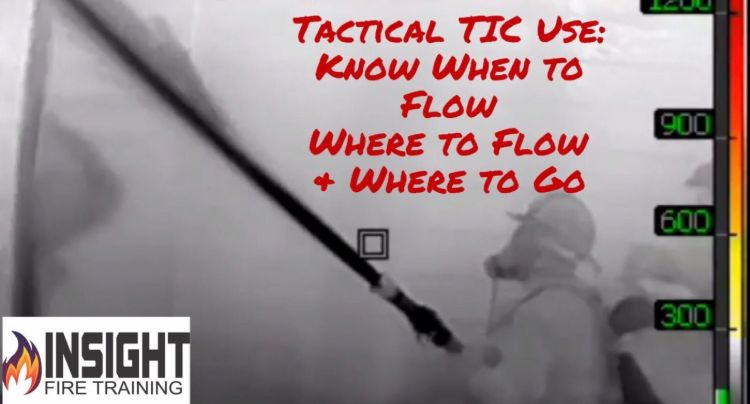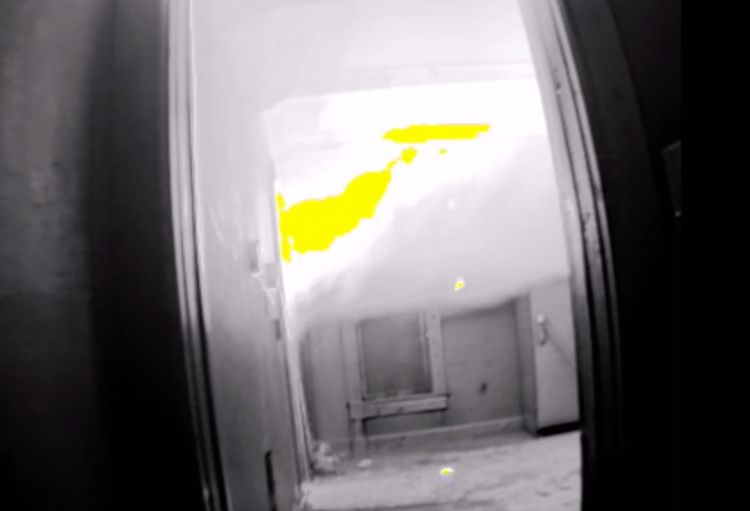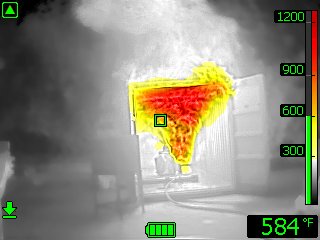Enhanced Stream Placement: Intelligently Aggressive Fire Attack

The issue with most water application isn’t the nozzle. It is the nozzle man. Water is often applied based on a method and an educated guess. In many cases, firefighters have withheld water because they didn’t see flames but were being cooked by a blast furnace of superheated gases and convection currents.
Tactical Thermal Imaging allows firefighters to direct their streams more efficiently toward where the water is needed most rather than all over or missing superheated areas. In many cases, of watching firefighters on standard training fires we have noted that firefighters only briefly open the nozzle before advancing and there is often temperatures of 800-1000 degrees still behind them. A trained crew leader can guide the efforts of the stream and ensure that superheated areas are “erased” and not merely penciled. As we can see in the following video, this highly skilled nozzle man (Matt Fullerton from Brothers in Battle) moves the stream and sufficiently cools almost every area within the fire environment erasing all of the heat.
There are heated fire service debates on many subjects but none will strike up a fierce conversation than the combination nozzle versus smooth bore debate. The issue comes down to context and what both sides do NOT see. Both types of applications are necessary and needed within the fire environment.
What is the problem then?
Firefighters were taught not to crawl past fire…
In our training, we teach NOT to crawl past heat or superheated fuels!
We erase the heat, we don’t merely briefly pencil.
This issue is compounded as “penciling” is a tactic from our overseas brethren that we have borrowed, butchered, and completely misused. Pulsing is used to cool gases and move forward. It is not an extinguishment technique and should not be randomly tried by non-trained personnel as the masters I have witnessed those who teach it, and they are surgically precise with their nozzle technique and application. Penciling is taught to reach out and cool surfaces further away not to check the overhead temperatures as many have been taught here in the US. As we can see in the following video, when a fire attack team advances without the guidance of a crew leader with a TIC, large superheated areas are missed and left behind them potentially endangering the victim, their home, and the firefighters.
Yet we consistently see firefighters across the US continuously crawl through convection ovens not adequately cooling the space.
We consistently hear radio traffic of firefighters not opening the nozzle because “we don’t have any visible fire but we are encountering high heat”
We consistently read and hear the following phrase:
“We are having trouble locating the fire”
Why guess? Why are they having trouble?
Because we consistently fail to use a device that assists us in locating the heat!
Without a thermal diagnostic tool to guide our efforts we are only seeing 1/3rd of the equation as 2/3rds of the heat energy is delivered within the infrared spectrum.
As we can see in the great photo by Max Fire Training, the fire attack team can clearly see the superheated areas and convection currents leading them to the seat of the fire. They can easily use the reach of the stream to cool where they are and cool where they are going. We recommend the following methodology:

C: Check the area around us and determine the location and severity of the fire.
C: Communicate to the Nozzleman where you want the water to be applied. Then instruct them using the clock method: “Flow Water from your 9 o’clock to your 3 o’clock until I tell you to stop.” In this manner, terms such as right & left aren’t miscommunicated in zero or limited visibility environments.
C: Cool Sufficiently all surfaces (wall, ceiling, wall, furniture, and sweep the floor), gases, and any off angle areas we often miss.
C: Confirm these areas are cooled below 200 degrees.
C: Continue forward and Conquer.
We hope these series of Enhanced Stream Placement Videos are helpful. If you would like to learn more, check out one of our courses such as our upcoming training at FDIC 2020. We greatly appreciate your support.
Instructor Andy Starnes
Insight Training LLC
Level II Thermography Certified.

